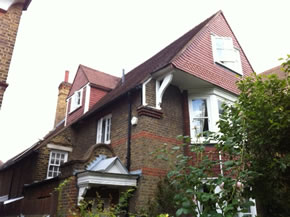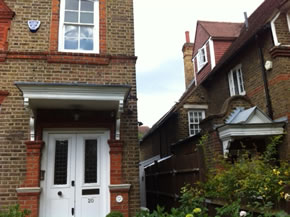A Wander Through Bedford Park
The architecture and literary heritage of the 'garden suburb'
|
Having spent two and a half hours ambling around the bohemian Victorian houses of Bedford Park – the first Garden Suburb – it is slightly disappointing to return to one’s own averagely sized and moderately designed house.
I have always loved looking at houses: the shape and size of them, the people going in and out of them, their location. I like an interesting shape and large windows and doors. Led by architect John Scott, of Oliver West and John Scott LTD., our enthusiastic group learned about the chronology of Bedford Park architects and the contexts in which they sit. The talk was part of the Bedford Park Festival.

Supporting Scott, lecturer Pamela Bickley brought the dense architectural detail to life with stories of W.B. Yeats’ unrequited love of Maud Gonne, which blossomed under an apple blossom tree in his garden on Blenheim Road. Both Scott and Bickley bring the houses of Bedford Park to life throwing light on properties I have never noticed, despite having lived in Chiswick for many years.
We begin in St Michael & All Angels Church, where Scott delivers a lengthy introduction on Jonathan Carr, a property speculator who bought twenty-four acres of land near Turnham Green station in 1875. This area later became Bedford Park, a suburb built for people moving away from Victorian Materialism and focusing on design and beauty. Bickley concisely summarises Bedford Park’s presence in various works of nineteenth and twentieth century literature, including G. K. Chesterton’s autobiography, which emphasises the separateness and perfection of Bedford Park, asking ‘what need is there to wander away?’ According to Chesterton, Carr’s design of a suburb with all the amenities for the creative middle class was indeed a success.
We exit the church to be confronted by The Tabard. Beckley professes that The Tabard was named after Chaucer, whose pilgrims meet in The Tabard Inn, in Canterbury Tales. A panel of William Morris tiles is tucked away at the pub’s side entrance, giving an impression of the high art culture Bedford Park was founded upon. Further down the road is Arts Ed. Originally called the School of Art, Art’s Ed was the only educational establishment Carr designed in the suburb, further evoking Carr’s expectations of creativity in the area.
We turn onto The Avenue, where architect Edward Godwin designed Bedford Park’s first houses. These were greeted at first with a good deal of criticism. Bickley turns our attention towards the Bedford Park Club, which was gloriously forward thinking for its time. Both men and women were allowed to participate in political discussion, producing the New Women of the 1880’s who wore divided skirts, cycled around town and ‘discussed the lack of evidence for male superiority’. A light chuckle echoes around the group, then John Scott brings us back to discussing the success of men, with the introduction of Norman Shaw’s popular, spacious and livable houses.
A left turn onto Blenheim Road leads us to The Studio, custom designed by Shaw for artist Edward Nash, with a north-facing window that gave constant natural light, without the glare of sunshine. Outside this fantastically Bedford-Parkian building, Scott imparts some knowledge of the local drainage system - it was haphazardly designed due to Carr’s make-it-up-as-you-go attitude, and the sewage was left to rot in ditches in the gardens. I preferred to consider the fascinating artistic history that stood behind us in The Studio.

We continue along Blenheim Road until Scott drew our attention to a beautiful, three-dimensional corner house. He explained exactly how Shaw designed the front and left-side walls with windows covering as much of the walls as possible. The other end of the house would have been used as the servant’s quarters with far less glass and far more brick. This is my favourite house on the walk.
It strikes me that I am taking part in something rather voyeuristic, as I peer into the windows of other people’s houses wondering how they may live differently from me. But I have come to realise that humans will always be voyeuristic of other humans as we strive to understand each other’s lives, cultures and differences, making this a very interesting afternoon of walking slowly through the lives of the Bedford Park residents.
Sophie Swithinbank
June 26, 2015